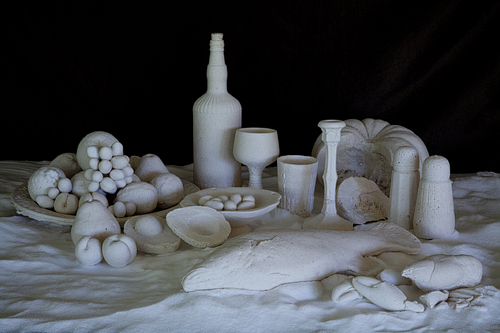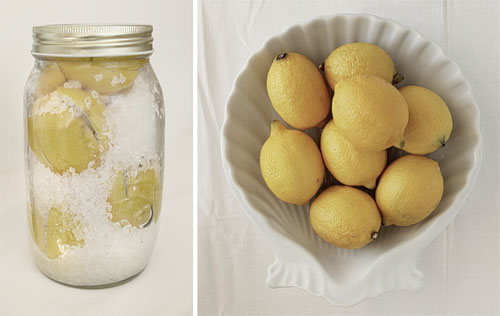In French, the term ‘still life’ is nature morte, which literally translates to dead nature. In Ken + Julia Yonetani’s Still Life: The Food Bowl (2011), the irony is not lost that a still life, depicting the nourishing foods that maintain life, is cast in a substance that simultaneously preserves food and prevents growth – thus embodying both life and death. Consumption and environmental decline are issues at the forefront of the work with the salt highlighting the death of the ecosystem from which the groundwater is pumped. The salt sculptures with their ghostly pallor and the effervescent fleeting ice forms embody the transient nature of the organic products. Through modern farming practices, shallow rooted plants replace native vegetation enabling the dissolved salts stored in the ground to rise and contaminate water systems on the surface. The result is saline water, demonstrating the way both water and salt are intrinsically linked. Through the Yonetani’s work, the need for a conscious awareness of where food is sourced and how its consumption effects the environment is reinforced.

* All the salt in this work was obtained from SunSalt, and originates from the Buronga Salt Interception Scheme on the Murray River.
Ken + Julia Yonetani directly reference the water issues of the Murray-Darling Basin in their sculpted still life tableaux, made by forming fruits and vessels from the salt drawn from the groundwater of the region. The Yonetanis began investigating the effects of salinity in the basin during their recent residency at Mildura. Ken Yonetani exhibited at the Venice Biennale in 2009 with sculptures made of sugar and it was this casting technique that was modified by them working with salt. Within the context of food production and preparation, salt possesses a dual nature. Historically it was used in the preservation of food, essential in sustaining life. However salt is also a poison. It prevents the growth of flora and the use of groundwater for irrigation. The title of the work suggests life; the produce and sea fare are living entities that have been contained within the sculpture.
The text from this post is excerpted from my article ‘Ken and Julia Yonetani / Janet Tavener‘ originally published in the June 2011 issue of Artlink Magazine.
Ken + Julia Yonetani’s exhibition, ‘Still Life: The Food Bowl’, will be on view at Artereal Gallery from 1 June – 2 July 2011.

Preserved Lemons
Yield: 1 large jar
The proportions of this recipe vary according to the size of your jar. I had a 1 litre jar and was able to fit 7 average size lemons and used around 400 grams of rock salt.
lemons
rock salt
large jar
Wash the skin of the lemons well and cut them in to quarters being careful to not fully slice through the end of the lemon. The lemon wedges should still be attached on one end.
Pack the inside of each lemon with salt. Add a layer of salt to the bottom of the jar and then carefully place the salt filled lemons. Fill in the gaps with salt, shaking the jar to ensure the salt is tightly packed around the lemons. Top with a final layer of salt and set in a dark, cool place.
After 1 week, the jar should be filled with juice. The lemons are now ready to cook with and enjoy. Will keep for up to 1 year and if you live in a hot climate, it is recommended to keep the lemons in the refrigerator.

7 comments
Megan Fizell (@tresjoliestudio) (@tresjoliestudio) says:
Jun 2, 2011
Ken + Julia Yonetani – Preserved Lemons http://goo.gl/fb/M53Uy #food #art
Rosa says:
Jun 2, 2011
This still life is awesome! I am a big fan of preserved lemon. Their flavor is inimitable.
Cheers,
Rosa
cha sen says:
Jun 3, 2011
a thoughtful treatise on the nature of the life-sustaining and the life-depleting. thank you.
Ed says:
Jun 3, 2011
I love that still life. I can’t remember where I saw it pictured but I’m almost tempted to come up and see it.
A few years back I made preserved lemons but I didn’t refrigerate them and they went slimy and possibly a bit mouldy. I suspect because Australia is so warm it is worth storing them in the fridge full stop.
Julie says:
Jun 4, 2011
The still life disturbs me slightly, as I feel our fruits and vegetables are becoming more and more tasteless as scientists work to make them larger and more disease resistant. Productivity is up, taste is down. I worry the chalky blandness of the still life foreshadows our food’s future.
deana says:
Jun 6, 2011
I love the salt still life. So disturbingly apt. It reminds me of some frozen Mrs. Havisham table… dead with the salt sucking the life and moisture through its coating so that the tableware is no different from what once was food.
Big Fan says:
Jun 13, 2011
I also love the salt still life. Julie must have been having a bad day when she posted her comments…